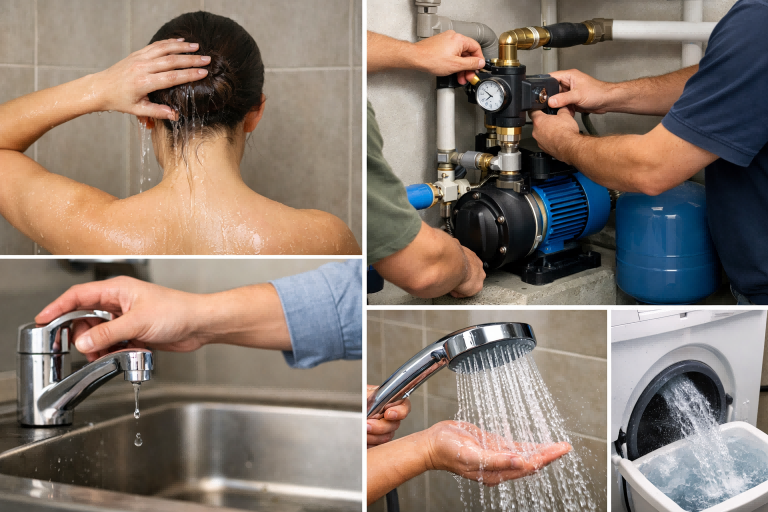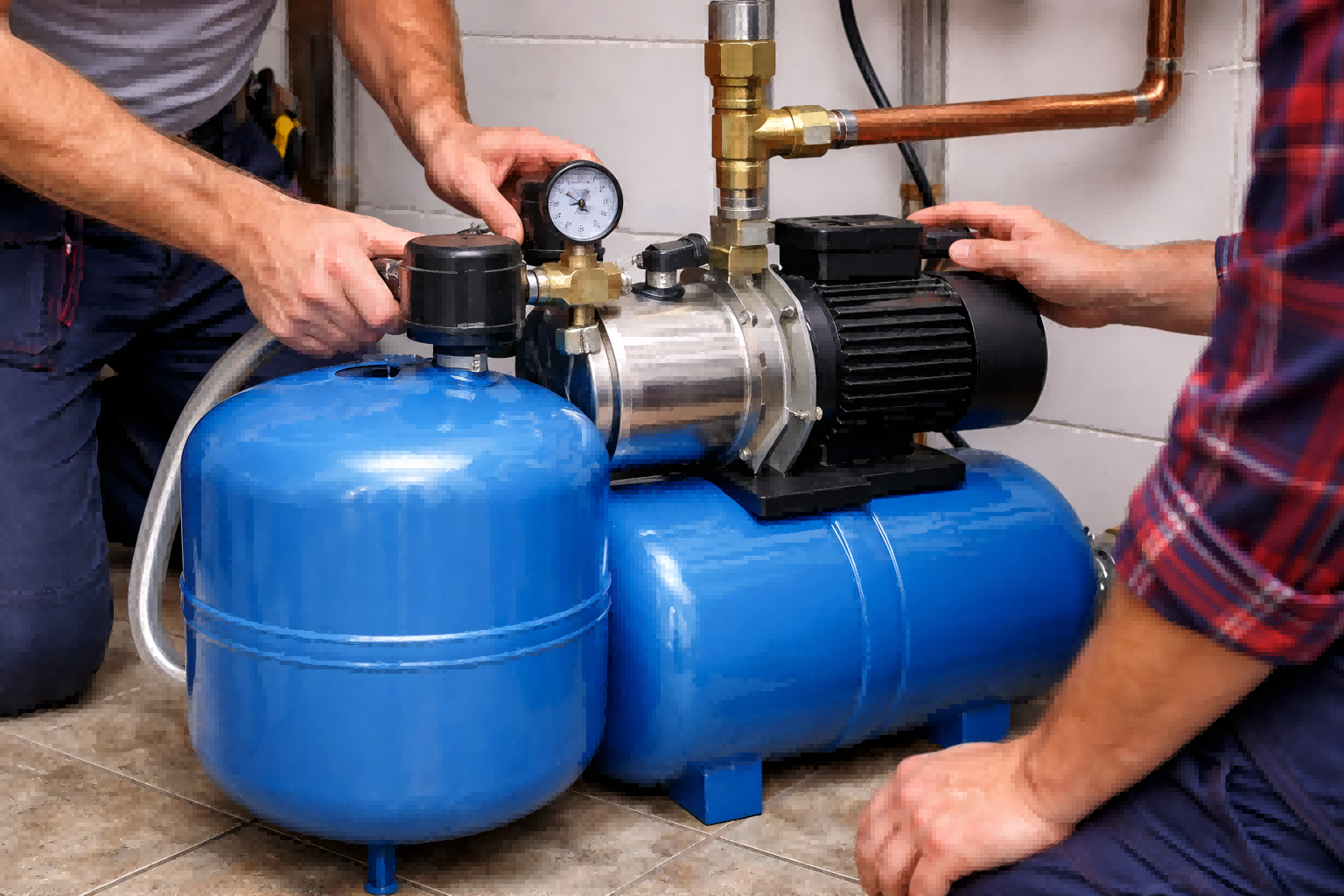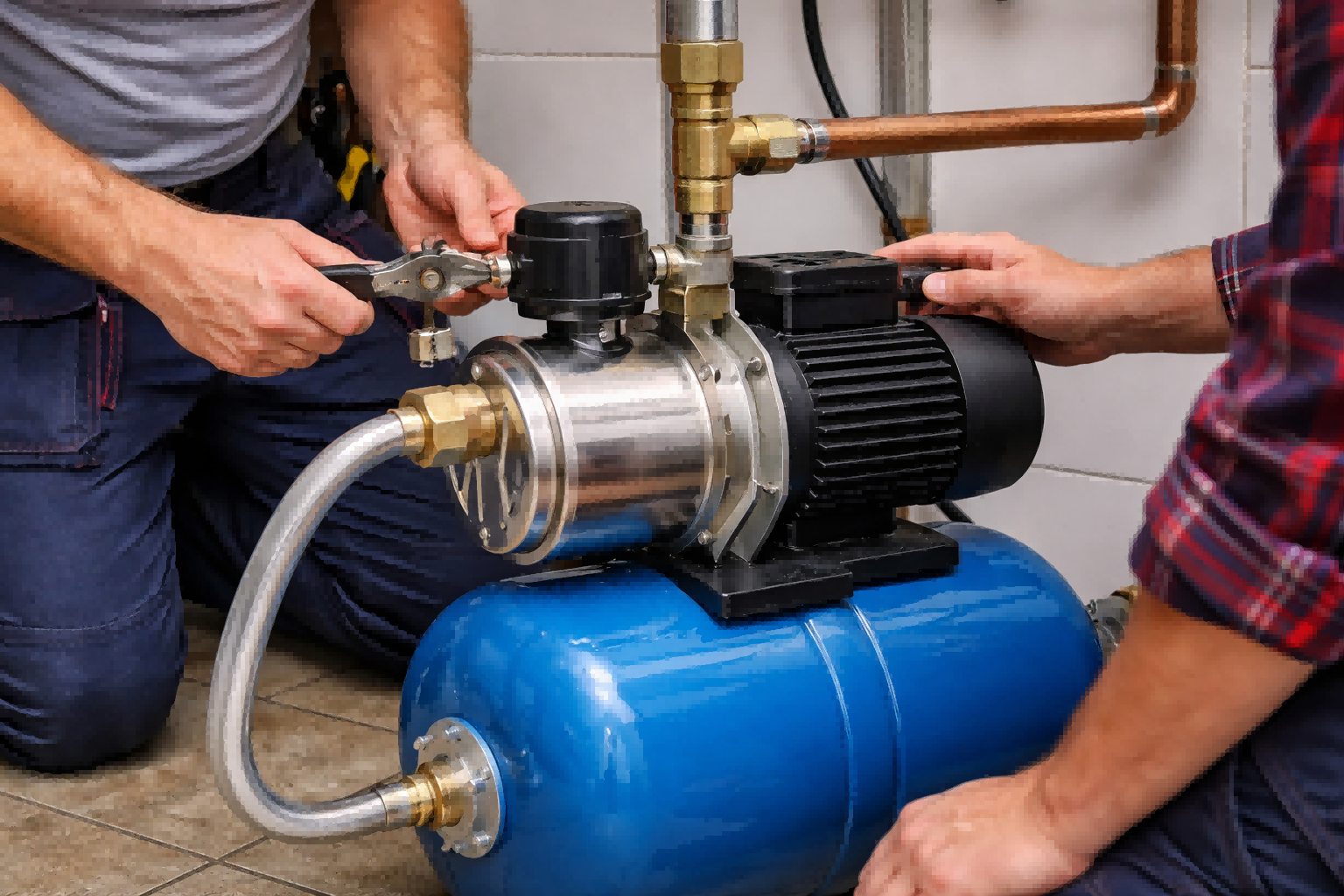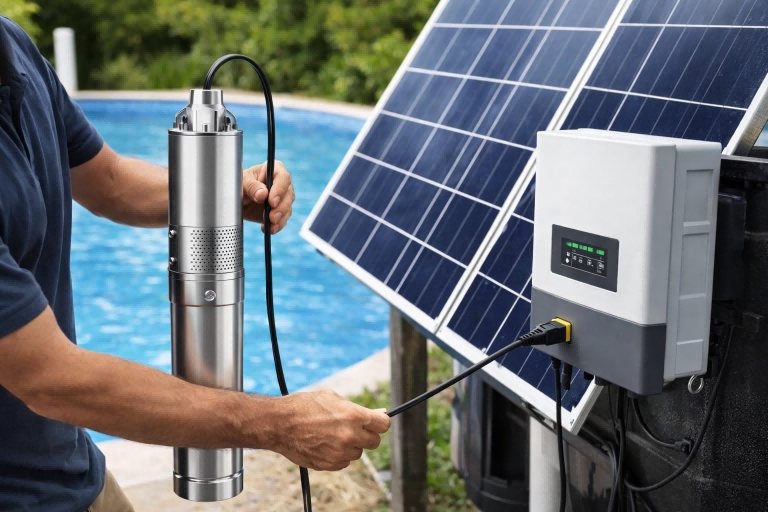Struggling with weak water pressure in a large building?
A single pump often fails to meet high demand.
This leads to inconsistent flow and user complaints.
A twin booster system is an integrated unit featuring two pumps connected in parallel. This design delivers powerful, reliable, and constant water pressure. It intelligently activates the second pump during peak demand, making it ideal for large domestic and commercial applications.
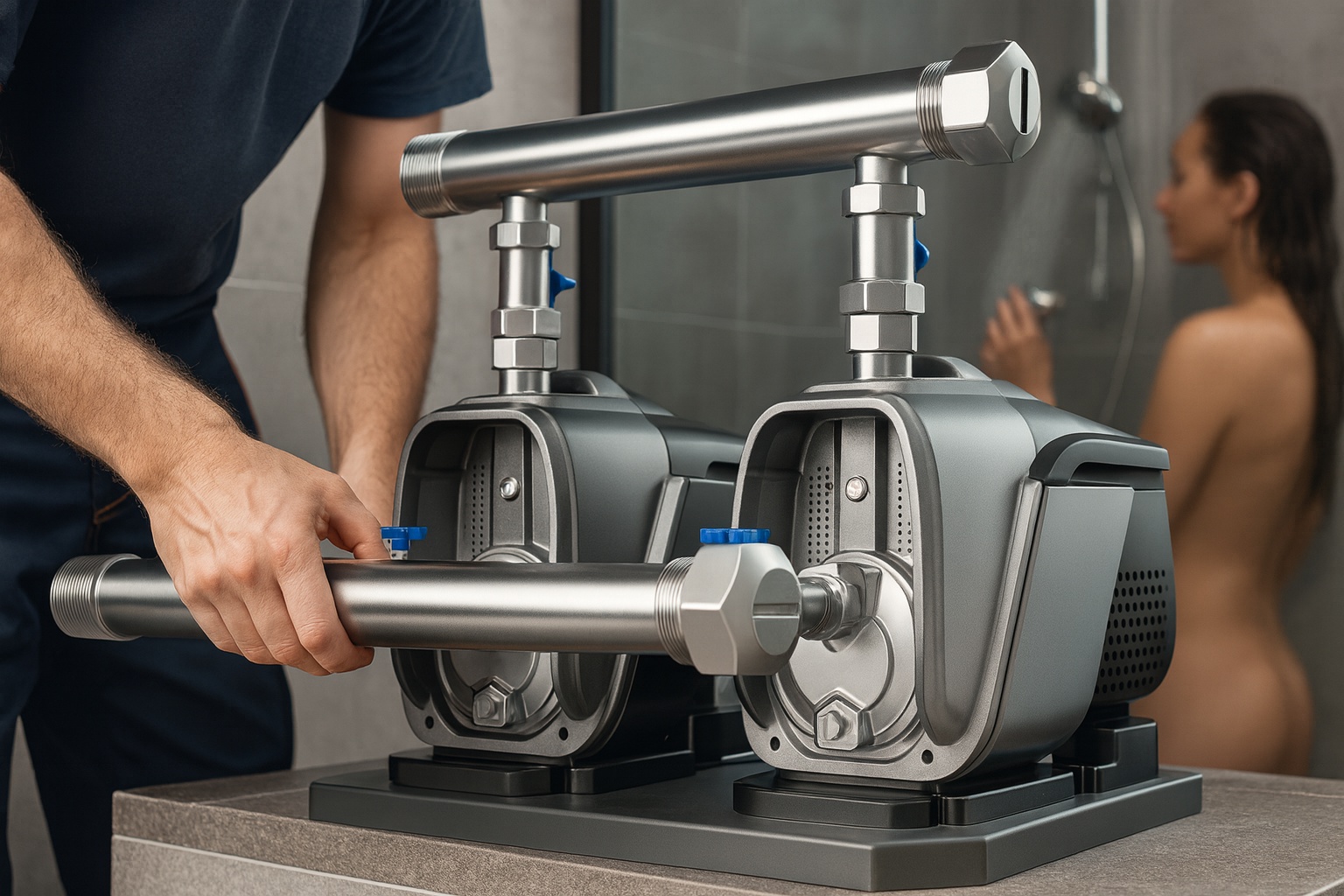
These advanced systems are far more than just two pumps working side-by-side.
They are meticulously engineered, all-in-one solutions built for optimal performance, efficiency, and exceptional durability.
Understanding the principles behind their operation reveals why they are the superior choice for demanding water supply challenges.
Let's delve into the mechanics and benefits that make these systems a cornerstone of modern water pressure management.
How a Twin Booster System Works
Is your current water system failing during peak hours?
Relying on one pump creates a significant performance bottleneck.
This results in frustrating pressure drops exactly when demand is highest.
Twin boosters solve this problem with intelligent control logic. One pump, the "lead," handles normal flow. The second "lag" pump activates automatically during peak demand. This ensures system pressure remains high and constant, regardless of usage.
The intelligence of a twin booster system lies in its automated control strategies, which are designed to maximize both performance and the system's operational lifespan.
These are not simply on/off systems; they are dynamic solutions that adapt in real-time to the building's water needs.
The core of this operation revolves around two primary functions: cascade control and pump alternation.
These features work together to deliver water efficiently and protect the hardware from premature wear.
Cascade Control for Peak Demand
Cascade control is the system's primary strategy for meeting variable flow requirements.
A pressure sensor, typically installed on the discharge manifold, constantly monitors the system's water pressure.
When water usage is low or moderate, only the designated lead pump operates.
If this pump is a variable speed model, it will adjust its motor speed to precisely match the demand and maintain the set pressure point.
However, when a large number of taps, showers, or appliances are used simultaneously, the demand may exceed the capacity of the single lead pump.
The controller detects the resulting pressure drop and instantly signals the second, or lag, pump to start.
This "cascade" effect brings the combined flow rate of both pumps online, immediately satisfying the high demand and restoring the system to its target pressure.
Once the demand decreases, the controller intelligently shuts down the lag pump to conserve energy.
Pump Alternation for Longevity
Running the same pump as the lead unit continuously would cause it to wear out much faster than the second pump.
To prevent this uneven wear and tear, twin booster systems employ a crucial feature called pump alternation.
The control system is programmed to automatically switch the roles of the lead and lag pumps after a set number of operating hours or start-stop cycles.
For example, the pump that was the lead pump yesterday might become the lag pump today.
This simple but effective strategy ensures that both pumps accumulate a similar number of running hours over their lifetime.
This balanced workload extends the service life of the entire system, reduces the frequency of maintenance, and improves overall reliability.
Advanced Control and Redundancy
Modern twin booster systems often feature even more sophisticated control logic for enhanced reliability.
-
Multi-Master Control: In some advanced systems, both pumps are equipped with full control capabilities. This means that if the primary control unit or its sensors were to fail, the second pump could seamlessly take over all control functions. This creates a fully redundant system where there is no single point of failure.
-
Fault Detection: The controller also monitors the operational status of each pump. If it detects a fault in the lead pump (such as an overload or overheating), it will automatically lock out the faulty unit and designate the second pump as the new lead. This ensures the water supply continues with minimal interruption until the issue can be serviced.
Key Components of a Twin Booster Setup
Building a reliable booster system from individual parts is a complex task.
Sourcing each component separately is time-consuming.
You risk facing compatibility issues, incorrect sizing, and a difficult installation process.
A twin booster is a pre-engineered, factory-assembled solution. It includes the pumps, motors, control panel, sensors, and manifold mounted on a single base plate. This integrated design guarantees compatibility and simplifies on-site installation significantly.
The "all-in-one" design philosophy is a key advantage of modern twin booster systems.
Manufacturers carefully select, size, and integrate each component to work in perfect harmony.
This approach eliminates the guesswork for installers and ensures the system performs as specified right out of the box.
From the robust mechanical parts to the sophisticated electronic controls, every element plays a critical role in the system's overall performance and reliability.
Let's break down the essential components that make up a typical twin booster set.
The Hydraulic Core: Pumps and Manifold
This is the heart of the system, responsible for moving the water.
-
Pumps: The set includes two identical pumps. These are often multi-stage centrifugal pumps, chosen for their ability to generate high pressure efficiently. The materials used are critical for durability, with stainless steel (like AISI 304) being a premium choice for impellers and pump housings due to its excellent corrosion resistance.
-
Manifold: The pumps are connected in parallel using common suction and discharge manifolds. These are engineered pipes that evenly distribute the flow of water to and from the pumps. They are typically made from stainless steel or another corrosion-resistant material and include connection points for gauges and sensors.
-
Check Valves: Each pump's discharge line is fitted with a check valve (non-return valve). This essential component prevents backflow through a pump that is not running, which is critical for proper parallel operation and protects the pumps from reverse rotation.
The Brains: Controller and Sensors
This is the electronic intelligence that manages the system's operation.
-
Control Panel / Cabinet: This houses all the electrical components, including the main power switch, circuit breakers, and the pump controller. In advanced systems, this controller is a sophisticated unit that manages cascade control, alternation, and all protective functions.
-
Pressure Sensor: This is arguably the most important sensor in the system. Installed on the discharge manifold, it provides real-time pressure readings to the controller, which uses this data to decide when to start, stop, or adjust the speed of the pumps.
-
Flow Sensor (Optional): Some systems may also include a flow sensor. This provides additional data to the controller for more precise control and can help in detecting conditions like dry running or very small leaks in the plumbing system.
The Foundation: Base Plate and Tank
These components provide the structural support and hydraulic stability for the system.
-
Base Plate: The entire assembly is mounted on a rigid, common base plate. This ensures perfect alignment between the pumps and manifold, reduces vibration during operation, and makes the entire unit easy to transport and install as a single piece.
-
Pressure Tank: Most booster sets include a hydro-pneumatic pressure tank. This small vessel contains a pocket of compressed air separated from the water by a diaphragm. It absorbs pressure spikes (water hammer) and can supply small amounts of water without starting a pump, which reduces the number of start/stop cycles and extends motor life.
| Component | Function | Key Material/Feature |
|---|---|---|
| Pumps (x2) | Generate water flow and pressure. | Stainless Steel Impellers, Multi-stage design |
| Control Panel | Manages pump operation and protection. | Cascade control, Pump alternation logic |
| Manifold | Connects pumps in parallel for combined flow. | Stainless Steel construction |
| Pressure Sensor | Monitors discharge pressure for the controller. | Real-time feedback for pump control |
| Base Plate | Provides a rigid, unified foundation. | Ensures component alignment, reduces vibration |
| Pressure Tank | Absorbs shocks, reduces pump cycling. | Protects against water hammer, extends motor life |
Core Benefits of a Twin Booster System
Unreliable water pressure costs you money and harms your reputation.
System downtime for pump repairs is a major operational headache.
You need a solution that is built to perform and last.
Twin boosters deliver exceptional reliability through built-in redundancy. If one pump requires service, the other can continue to supply water. They also provide superior performance, constant pressure, and a longer overall equipment lifespan.
Investing in a twin booster system offers significant advantages over using a single, larger pump, especially in applications where water supply is critical.
The benefits extend beyond just providing more water; they encompass reliability, efficiency, and long-term asset protection.
The design is inherently robust, ensuring that end-users receive a consistent and comfortable water experience while building owners enjoy peace of mind and lower operational costs.
These core advantages make twin boosters the professional standard for commercial and high-end residential projects.
Unmatched Reliability and Redundancy
This is the most significant advantage of a twin pump system.
With two pumps available, the system has built-in backup.
-
Operational Redundancy: If one pump fails or needs to be taken offline for scheduled maintenance, the second pump can automatically take over the full load (up to its capacity). This ensures there is no complete interruption of the water supply, which is critical for applications like hotels, hospitals, and residential complexes.
-
Minimized Downtime: The ability to service one pump while the other remains operational drastically reduces system downtime. Maintenance can be scheduled conveniently without causing major disruptions to the building's occupants.
Superior Performance and Constant Pressure
Two pumps working in concert can deliver performance that a single pump often cannot.
-
High Peak Flow Capacity: The system can meet extremely high, short-term demands by running both pumps simultaneously. This is ideal for buildings where usage patterns vary widely, such as a residential building during morning hours or a commercial facility with industrial processes.
-
Stable, Constant Pressure: The integrated controller, especially in Variable Frequency Drive (VFD) models, continuously adjusts pump operation to maintain a perfectly stable discharge pressure. This eliminates the frustrating fluctuations common with older systems, providing a high level of comfort for users.
Enhanced Energy Efficiency
A twin booster system can be significantly more energy-efficient than a single large pump designed for peak load.
-
Right-Sized Operation: For most of the day, when water demand is low, only one small pump needs to run, consuming minimal energy. A single large pump, in contrast, would be operating far from its Best Efficiency Point (BEP), wasting electricity.
-
Variable Speed Control: Models equipped with VFD motors are the pinnacle of efficiency. The VFD allows the motor to run at precisely the speed needed to meet the demand, rather than running at full speed all the time. This can result in energy savings of 50% or more compared to fixed-speed systems.
Extended System Lifespan
The design and control logic of a twin booster system actively work to prolong the life of its components.
-
Reduced Wear from Alternation: As discussed, the pump alternation feature ensures that wear and tear is evenly distributed between the two pumps, doubling the effective life of the system's hydraulic components compared to a single-pump setup.
-
Fewer Start/Stop Cycles: The inclusion of a pressure tank absorbs minor pressure drops, preventing the pumps from starting for small uses like flushing a toilet. This reduction in cycling significantly reduces wear on the motor, seals, and electrical components.
Understanding Key Technical Specifications
Choosing the wrong pump leads to poor performance and energy waste.
Technical datasheets can be complex and confusing.
Misinterpreting these specifications can result in purchasing a costly system that is either oversized or undersized for the job.
To select the right twin booster, you must understand its key specifications. These include the flow rate (m³/h), head range (metres), power rating (kW), and construction materials. Matching these specs to your application's demands is crucial.
A technical data sheet provides a complete engineering profile of the booster pump system.
For importers, distributors, and installers, being able to accurately read and interpret this data is essential for sizing a system correctly and advising clients effectively.
A well-matched system will operate efficiently and reliably for years, while a poorly sized one will struggle.
Let's break down the most critical technical specifications found in the documentation for twin booster sets, using common examples to illustrate their meaning.
Hydraulic Performance: Flow and Head
These two parameters define the pump's primary function.
-
Flow Rate (Q): This measures the volume of water the pump system can move in a given period. It is typically expressed in cubic metres per hour (m³/h), gallons per minute (GPM), or litres per second (L/s). The required flow rate is determined by the maximum number of fixtures the system needs to supply simultaneously.
-
Head Range (H): This represents the pressure the pump can generate, expressed as the equivalent height it can lift a column of water. It is measured in metres (m) or feet (ft). The required head is calculated based on the building's height, pipe friction losses, and the desired final pressure at the tap.
Mechanical and Material Quality
These specifications indicate the system's durability and suitability for different types of water.
-
Pump Housing and Impeller Material: Look for high-quality, corrosion-resistant materials.
- Stainless Steel (AISI 304/316): The premium choice, offering excellent resistance to corrosion and wear. Ideal for drinking water applications.
- Cast Iron (with CED coating): A robust and cost-effective option. Cathode Electrode Deposition (CED) coating provides good corrosion resistance.
-
Shaft Seal: This prevents water from leaking out along the motor shaft. The materials (e.g., Carbon/Ceramic/EPDM) determine its durability and compatibility with different water temperatures and qualities.
-
Maximum Liquid Temperature: This specification indicates the highest water temperature the pump can safely handle, typically measured in °F or °C. This is important for applications involving hot water circulation.
Electrical Data and Compatibility
This information is vital for ensuring the system can be safely and correctly installed.
-
Rated Power (P2): The motor's output power, usually given in kilowatts (kW) or horsepower (HP).
-
Rated Voltage and Frequency: This specifies the required electrical supply (e.g., 1 x 200-240 V) and frequency (e.g., 50 Hz or 60 Hz). It is critical to match this to the local power grid.
-
Insulation Class (e.g., Class F): This indicates the motor windings' ability to withstand high temperatures, which relates directly to motor longevity.
-
Protection Rating (e.g., IP55): The IP code defines the motor's level of protection against solids (dust) and liquids (water). A higher number indicates better protection.
| Specification | Description | Example from Document | Importance |
|---|---|---|---|
| Flow Range | Volume of water moved per hour. | up to 28 m³/h | Must meet the building's peak water demand. |
| Head Range | Maximum pressure generated (as height). | up to 82 metres | Must be high enough to serve the tallest floor. |
| Pump Material | Material of impellers/housing. | Stainless steel / Cast Iron | Determines durability and corrosion resistance. |
| Rated Voltage | Required operating voltage. | 1 x 200-240 V | Must match the available electrical supply. |
Conclusion
In summary, twin booster systems provide a reliable, efficient, and powerful solution for constant pressure.
They excel in applications where demand varies and uptime is critical.
FAQs
What is the purpose of a booster pump set?
A booster pump set is used to increase low water pressure. It ensures a strong, consistent water supply throughout a building, especially in multi-story or large-footprint properties.
What is the difference between single and twin booster pumps?
A single booster has one pump. A twin booster uses two pumps working in parallel, providing higher flow capacity, automatic backup, and better efficiency under varying demand.
How do you control two booster pumps?
They are managed by an integrated control panel. This controller automatically alternates pump usage to equalize wear and runs both pumps simultaneously when water demand is very high.
What is cascade control in pumps?
Cascade control is a strategy that starts additional pumps in sequence as flow demand increases. This ensures the system operates efficiently by only using the energy that is needed.
Do I need a pressure tank with a booster pump?
Yes, a pressure tank is highly recommended. It reduces pump cycling for small water uses, absorbs pressure shocks (water hammer), and helps maintain a more stable system pressure.
Can a booster pump be used for hot water?
This depends on the specific model's materials and seals. Some systems are designed to handle elevated water temperatures, making them suitable for hot water circulation applications.
What does pump alternation mean?
Pump alternation is a feature where the control system regularly switches which pump serves as the primary (lead) unit. This balances operating hours and wear between the two pumps.
Are twin booster systems noisy?
Modern systems, especially those with VFD motors, are designed for quiet operation. Many models operate at levels below 57dB, which is quiet enough for installation near occupied spaces.


